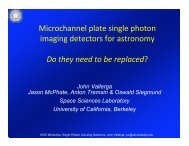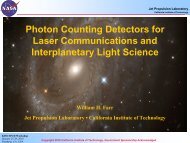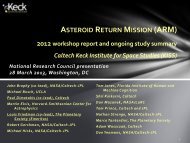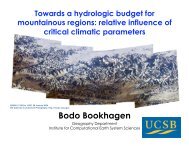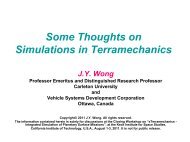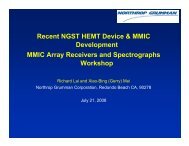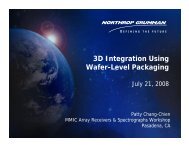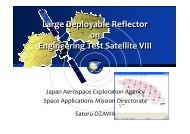DRAFT: RELEASED FOR PUBLIC COMMENTWhile there is much we know, there is still much to be learned about the <strong>NEO</strong> population thatis directly relevant to NASA’s Exploration Systems Mission Directorate (ESMD) concerns. Thesmaller bodies most likely to be visited by humans are not as well studied as the larger ones.We have relatively few density measurements for small asteroids. There is evidence that satellitesform, evolve, and escape from <strong>NEO</strong>s, with the escaped bodies becoming independent members ofthe <strong>NEO</strong> population [17, 18]. The internal structure of such escapees is not obvious, however, noris it clear how such objects might systematically differ from their parents. In addition, roughly 10%of <strong>NEO</strong>s larger than 200 m in diameter are contact binaries, another possible end state of binaryevolution.Table 2, adapted from the National Research Council’s (NRC’s) “Defending Planet Earth: Near-Earth Object Surveys and Hazard Mitigation Strategies” 3 shows the characterization situation.Table 2 shows that most known <strong>NEO</strong>s have no characterization at all, while a few hundred to afew thousand have some sort of spectral data available. A handful have been characterized verywell by spacecraft. The potential human spaceflight targets are most likely not yet discovered, andas more data are collected they will be better understood until they are suitably characterized orruled out as viable targets. While observations from WISE and Spitzer have increased the numberof <strong>NEO</strong>s with known albedos and sizes since Table 2 was created [13, 19], it is still true that formost objects all we know is an absolute magnitude and an orbit of varying quality.Table 2: Characterization Levels for <strong>NEO</strong>sNumber<strong>NEO</strong>s larger than 50 m diameter (estimated) ≈ 500,000 - 1,000,000 *<strong>NEO</strong>s currently known (all sizes) 6,278Rotation periods 450Rotation pole directions 25Detected by radar 246Shapes estimated from radar data 25Shapes estimated from optical data 14Shapes estimated from spacecraft data 2Masses estimated from spacecraft data 2Masses estimated from radar data 4Bulk densities estimated from all sources 10Sizes estimated from all sources 108Near-surface densities estimated from radar 17Spectrally classified into taxonomic groups 489 *** Estimate based on current models.** As of February 2011, as reported by the European Asteroid Research Node (http://earn.dlr.de).4.2 Characterization Information Relevant to Human ExplorationUntil recently, the vast majority of <strong>NEO</strong> data have been collected in support of either basic scientificresearch or in consideration of the general impact hazard. Much of these data, while not specifically3 Found at http://www.nap.edu/catalog.php?record_id=12842DRAFT: RELEASED FOR PUBLIC COMMENT 11
DRAFT: RELEASED FOR PUBLIC COMMENTcollected for this purpose, bear directly on ESMD and HSF requirements. While the choice ofthe asteroid first visited by a human crew will be dictated by flight dynamics and human safetyconsiderations, it will still be important to characterize the chemical composition and structure ofthe target as thoroughly as possible in order to ensure that the crew brings tools and experimentsappropriate to the geology of the target.First, the knowledge of orbits for <strong>NEO</strong>s varies in quality from <strong>NEO</strong>s with orbits that are welldetermined and can be extrapolated with high confidence to those with insecure orbits. Whilesome of the latter may appear to be accessible, improvements in their orbits may leave themless attractive. Worse yet, many objects with insecure orbits are effectively lost, with positionaluncertainties too high to allow recovery. The set of ESMD mission candidates will be drawn fromobjects with high-quality, secure orbits.Lightcurve observations, commonly made for <strong>NEO</strong>s by professional and amateur astronomers usingphotometry, provide rotational periods and thus the angular speed of the surface. The amplitudeof the lightcurve provides a measure of the axial ratios of the target body, and repeated lightcurvemeasurements from different viewing aspects allow the three-dimensional shape of an object to beestimated. Repeated measurements will also reveal the direction of an object’s rotational pole,important for understanding the duration of daylight across its surface. Objects in non-principalaxis rotation (tumbling) can also be identified by this technique.Knowledge of the <strong>NEO</strong>’s rotational characteristics will determine the overall suitability as a humandestination, since objects rotating too quickly will be difficult to interact with for both engineeringand human factor reasons. The majority of objects smaller than ≈ 150 m have rotation periodsshorter than ≈ 2.2 hours, seen as a rough limit on suitable rotation rate [15]. However, whilestatistical arguments may suggest a small object will be rotating too quickly to serve as a viablemission target, measurements still must be made of specific bodies to make the actual determination.Lightcurve observations can also identify binary objects, although radar studies from Arecibo andGoldstone provide the most easily interpretable results. Roughly 15% of <strong>NEO</strong>s are found to bemembers of binary or multiple systems, with current models suggesting satellite formation andorbital evolution via the Yarkovsky-O’Keefe-Radzievskii-Paddack (YORP) force and tidal forces[17, 18]. As mentioned above, the fraction of binary <strong>NEO</strong>s appears to be correlated with rotationrate.It is not clear whether the presence of a satellite would disqualify an object as an HSF target orincrease the risks involved in such a visit in a significant way. It is possible that the orbital dynamicsin such a system would complicate operations to an intolerable extent; however, the scientificrewards for visiting such a system may justify the additional complications. Understanding thehazard posed by smaller-scale satellites (the volume density and size distribution of < 1 m sizeobjects) will also be important before astronaut arrival, though the slow orbital speeds will likelymake such debris a nuisance rather than a hazard.Binary or multiple systems are also one of the few situations in which <strong>NEO</strong> masses can be calculated.Given a satellite system, Kepler’s laws can be used to calculate a system mass. In non-multiplesystems, high-precision positional measurements combined with estimates of thermal propertiescan be used in some cases to measure the Yarkovsky force on a <strong>NEO</strong>, which is mass dependent. Incases where neither approach is possible, an in situ visit is required to estimate an object’s mass.DRAFT: RELEASED FOR PUBLIC COMMENT 12




